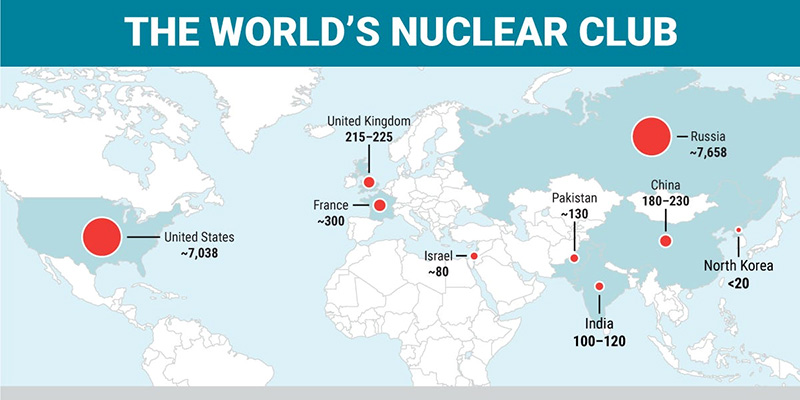 Map: Business Insider
Map: Business Insider
The choice of Hiroshima as the venue of May’s G7 meeting implied that the issue of nuclear disarmament would be highlighted in the summit documents. Not surprisingly, the G7 leaders issued the “Hiroshima Vision on Nuclear Disarmament” to mark the occasion, writes Kanwal Sibal, retired Indian foreign secretary and former Ambassador to Russia, he also held ambassadorial positions in Turkey, Egypt, France and was Deputy Chief of Mission in Washington DC.
It was essentially a ritualistic exercise to cater to Japan’s special sensitivities on the nuclear issue as the only country ever subjected to a nuclear attack. Not highlighting the nuclear disarmament issue would not have been possible morally, and politically too as Hiroshima is part of Japanese Prime Minister Kishida’s constituency.
What was not possible was to give life to something that is virtually moribund. Hence, the vision statement is not an entirely honest document. It is politically self-serving, distorts the realities on the ground and contains much posturing.
The document begins by acknowledging that Hiroshima is a reminder of the “unprecedented devastation and immense sufferings of the people of Hiroshima and Nagasaki experienced as a result of 1945 atomic bombings.” However, it neither condemns the use of nuclear weapons nor says who was responsible. Understandably so since the document is issued in the name of the US among others.
The signatories speak of their commitment to “achieving a world without nuclear weapons with undiminished security for all.” The thought behind such an assertion is not clear. Nuclear weapons are seen by those possessing them as ultimate providers of security against existential threats. If they are eliminated, how would the concept of “undiminished security for all” operate?
Will it be through a deterrent balance in conventional arms, which means more advanced conventional weaponry and more defense allocations? Who are the “all” it speaks of – obviously not the non-nuclear-armed countries?
The concept of “undiminished security” and the related concept of “equal and indivisible security” has not worked in geographies hitherto central to these concepts. It has not worked in Europe. If it had, the world would not be seeing the present conflict in Europe over Ukraine in which nuclear powers are pitted against each other, with unpredictable consequences.
The document berates as “dangerous and irresponsible” Russia’s “nuclear rhetoric, undermining of arms control regimes, and stated intent to deploy nuclear weapons in Belarus.” But in fact, it is the US that abrogated the Anti-Ballistic Missile (ABM) Treaty with Russia in 2002, in the belief that it could develop an impenetrable ballistic missile defense.
Leaving aside the polemics around it, it is the US again that in 2019 withdrew from the INF Treaty. Trump while in office was even hinting that he would not renew the New START Treaty.
Now with both Russia and the US suspending the operation of this treaty and associated inspections in the wake of the Ukraine conflict, its future has become uncertain. Denouncing Russia’s intention to deploy nuclear weapons in Belarus raises the question about the existing deployment of US tactical nuclear weapons in six bases in five NATO countries: Belgium, Germany, Italy, the Netherlands, and Türkiye.
The G7 vision document says that the “overall decline in global nuclear arsenals achieved since the end of the Cold War must continue and not be reversed.” But what about modernisation of existing arsenals and pursuit of more advanced nuclear weaponry within the agreed limits under the New START Treaty?
In 2010, former US President Barack Obama authorized a nuclear modernisation programme that would cost $1 trillion over the next 30 years. It called for a slew of new cruise missiles, ICBMs, nuclear submarines, and long-range bombers over the next three decades. The US Congressional Budget Office estimated in May 2021 that the US would spend $634 billion over the next 10 years to sustain and modernize its nuclear arsenal.
In the document the G7 members reaffirm their “commitment to the ultimate goal of a world without nuclear weapons with undiminished security for all, achieved through a realistic, pragmatic and responsible approach.” This is posturing, given the caveats attached to this commitment. How is “realistic, pragmatic and responsible” defined?
The signatories have given themselves all the leeway they need to make a noble-sounding statement without committing themselves to any foreseeable timeline or accountability, stresses Kanwal Sibal.
read more in our Telegram-channel https://t.me/The_International_Affairs

 11:43 07.06.2023 •
11:43 07.06.2023 •






















